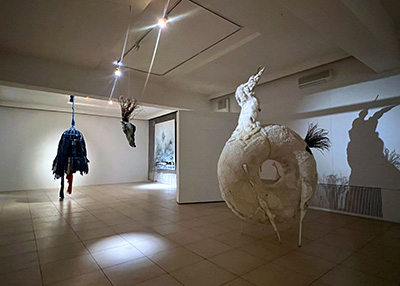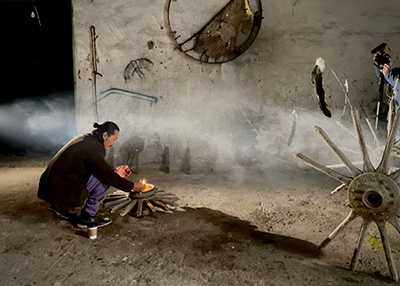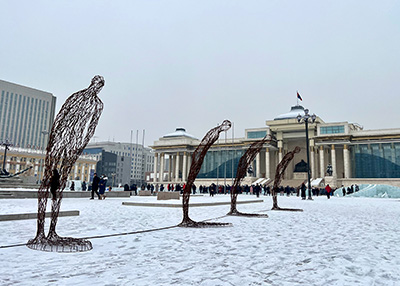Fieldwork
When I asked artist A. Ochirbold on his thoughts about how people were using his sculptures, named “Consciousness” (“Ухамсар”), to protest against the government, which actually bought those sculptures and installed them in public, thereby enabling such uses in the first place, he said to me: ‘firstly, I give myself an answer, afterwards people give me answers’. Conducting fieldwork in Mongolia with contemporary artists, visuality constitutes a vital part of my embodied experience in the field. Thus, alongside textual fieldnotes, I have adopted photography as an integral means of ethnographic documentation. The photographs presented are selected based on their colours, composition, and their ability to help me, the anthropologist, to recall and reflect upon my experiences in the field. However, instead of burdening these photographs with the responsibility to narrate specific stories, I hope for them, with the particularity of their visuality, to elicit thoughts and feelings from their viewers, who may well be unfamiliar with my field-site, and in turn feed audiences’ impressions, comments, and imaginations back to me. As such, I hope for the exhibition of these photographs to be part of my research process, as the exhibition of artworks constitutes for the artists with whom I work.
27 October 2022, Union of Mongolian Artists Art Gallery. Contemporary Art Mongolia 2022 exhibition, curated by Professor Ch. Boldbaatar. Works left to right: B. Manajaw, “Чимээгүй Чимээ” (literally “Silent Noise”), installation; B. Orkhontuul, “Сэргээлт” (meaning renewal, revival, or restoration), mixed media; B. Orkhontuul, “Зөн Дахь Эх” (“Mother of Visions”), installation. Strikingly symbolic materials, such as khadag (traditional ceremonial scarves), felt, sheep skin, and an animal skull come in sharp contrast with the mixed-media installation as an epitomic form of contemporary artistic expression, symbols of modern progress such as the astronaut and the figure of a geometrical wheel, the tiles and walls of a modern urban gallery situated in the heart of Ulaanbaatar. This interaction between the stereotypes and romances of ‘traditional nomadic Mongolia’ and post-modern realities that condition the lives of citizens of Ulaanbaatar today sets out numerous questions I am continuing to explore through my fieldwork.
18 November 2022, artist D. Dorjderem lighting up arts (арц; juniper) as part of his art performance at Art Week 2022. “This arts comes from the high mountains in Bayankhongor, where my grandmother and my great grandmother are from,” Dorjderem explained. “She gave me everything,” he continued solemnly in his deep voice, while lighting up a cigarette just outside the exhibition hall, with rather heavy snow falling on both of us. “She had a rich life, so I have a rich life,” he said with his limited yet exceptionally precise English, “She would have been 110 years old if she was still alive. This is for her.” At the same time when Dorjderem was conducting his performance, the Minister of Culture was filming an interview with the official crew from the Ministry and some media journalists on the other side of the same room. When the Minister finished her interview, through which she was promoting this very exhibition, she walked straight past an artist conducting a live performance, albeit a silent one, and left the room swiftly into her next interview filming spot. “The government… I don’t care,” some artist said later. “If she comes alone, that’s better,” another added.
11 December 2022, Sukhbaatar Square. Artist A. Ochirbold’s sculpture series, “Consciousness” (“Ухамсар”), standing in the middle Sukhbaatar Square, while a crowd of citizens demonstrated against ‘coal theft’—the alleged illicit export of coal to China in which high-level parliamentary members were suspected of engaging—in front of the Government Palace. The encounter between Ochirbold’s sculptures with demonstrators was merely coincidental, but an activist group had also intentionally protested in front of Ochirbold’s sculptures and circulated such photographs on Facebook during the same week when this photograph was taken. On 17 May 2023, artists working for public institutions organised a march to Ministry of Culture and staged a demonstration in front of the Ministry, where one of Ochirbold’s “Consciousness” sculptures also stood, calling for an increase in salaries and improvement in working conditions. Some of the demonstrators stuck posters on the sculpture, such as one reading “Соёлын сэргэлт биш сөхрөлт болж байна” (meaning “it is not a revival of culture but a collapse of it”), and many shared photographs of it on social media, even though a few of whom I asked did not actually know anything about Ochirbold’s sculptures.



